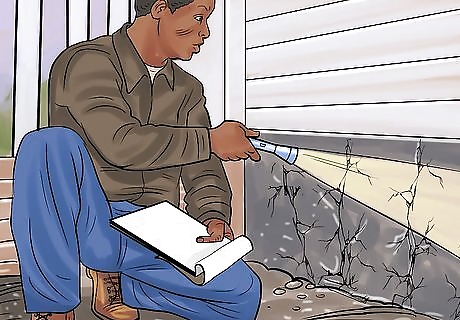
views
Requesting Disclosures

Identify what sellers must disclose. In the U.S., federal law requires that certain disclosures be made to buyers. For example, sellers must disclose the presence of lead-based paint or asbestos if the home was built prior to 1978. Your state and local law will also have additional disclosure requirements. You should get copies of the law to see what you are entitled to. Search online or stop into your local city planning department to ask. You can also ask a real estate agent or an attorney for a copy of the disclosure law. Your state’s Department of Real Estate might also have information about what disclosures are required in your state.

Request the disclosure form from the seller. The disclosure form allows the buyer to cancel the contract within 3 days of receiving the disclosures without penalty. If the seller does not give the buyer the disclosures, then that leaves the buyer open to cancel the contract for no reason at any time for any reason. The seller or the seller’s agent should send this to you without any prompting. However, if you haven’t received it yet, then call and ask for it. Make sure you have all of the sheets and that you can read the information. Also compare what you received to what the seller was required to give you. Confirm that the seller has turned over all required disclosures. Purchase agreements usually do not have a deadline for a seller to provide the disclosures. It’s up to the buyer to request them if the seller does not provide them. If the seller still does not provide them, then the buyer can cancel the contract and walk away without penalty or have a full inspection to find out what is going on. HUD homes are exempt from completing disclosures and will never provide them so it should be up to the buyer to do their due diligence and not rely on seller disclosures entirely.

Analyze the disclosures. Set aside some time to go through the disclosure forms. Note anything that you don’t understand or any information that is missing. Also check what problems have been identified. In most states, owners are not legally responsible for any problems they are unaware of. They could honestly answer that they are unaware of any termite infestation when there is an actual infestation. Most states don’t require that sellers go looking for problems. Realize that owners also don’t have to hire someone to search for problems unless they agreed to this in the purchase agreement. For this reason, you shouldn’t assume no problems exist with the house simply because they aren’t noted on the disclosure form. If a buyer conducts an inspection and provides a copy to the seller and the sale falls through, the seller is required to disclose what was uncovered in the inspection report along with the original disclosures.

Ask for any missing information. If information is missing from a disclosure form, then follow up with the seller or their agent. Request the missing information. Remember not to go through with the purchase until you receive complete disclosures. Disclosure laws should typically cover the following: water leakage of any kind, including around windows and in basements termites or other insects pests, mold, or rot plumbing and sewage problems defects in the roof drainage problems issues with air conditioning and heating foundation problems boundary disputes with a neighbor issues with the legal title other (depending on the state)
Hiring an Inspector

Negotiate a right to an inspection. You should never rely solely on disclosures to protect you. Instead, you need a home inspection done. In fact, an inspection should be one of the “contingencies” of the contract. This means you can cancel the contract based on the results of the inspection. Even if the seller already had an inspection done before putting the home on the market, you should think about hiring your own inspector. This can be expensive, especially if the house is big, but it’s money well spent. You’d rather find problems before agreeing to buy a house. Your contract can also set the timetable for the inspection. An inspection timeline is typically 10 days by default, but you may be able to negotiate to get a few more days.

Obtain referrals for an inspector. You might not know any inspection companies. Although you can search for inspectors online, it can be difficult to judge inspectors based on their websites. Obtain referrals from people you trust, such as real estate agents, lawyers, other homeowners, or the International Association of Certified Home Inspectors (www.nachi.org). When a real estate agent refers an inspector, they are required to disclose what type of relationship, if any, they’ve had with the inspector in writing. This ensures that the buyer is aware of any conflicts of interests or third party benefits that come with hiring the inspector.

Choose an inspector. Ask inspectors if they can provide references. Call up the references and check that the people were happy with the service provided. Ask if the inspector showed up on time and did a complete inspection. Obtain a quote in writing for how much it will cost to hire the inspector. Winnow down your list and hire the inspector whose price and reputation works for you. Most inspectors take photos of the issues and include them in the report. Make sure that you ask the inspector if they do this before you decide to hire them.
Read your inspection report. The inspection should take 2 to 5 hours. Once finished, the inspector should give you and your agent a report of about 20-30 pages. You should also get color photographs of any problems. Don’t be surprised if there are problems. A good home inspection should be thorough and identify even small flaws. Discuss with your agent or lawyer whether any of the problems seem particularly serious or expensive to fix. If so, you’ll need to consider next steps. For example, if you are in a “seller’s market,” you might want to avoid asking the seller to fix minor issues. However, you shouldn’t ignore big structural flaws, like a cracked foundation.

Hire specialty inspectors, if necessary. A general inspection can reveal certain problems, such as low water pressure. However, you might need to hire a specialist to uncover the root cause of the problem. If your inspector recommends additional inspection by a specialist once an inspection has been completed, then you’ll need to make a request to the seller to allow it. If the seller denies this, then you may have to decide if you’d like to purchase as is or cancel. Inspector specialists work in the following areas: chimney electrical heating and air conditioning termites and other pests lead-based paint easement and encroachment roofs foundation and basement trees, vegetation, and soil stability septic system or sewer (septic system inspection or drainage of the system is generally a separate contingency to the actual inspection contingency) mold other

Work with the seller to correct problems. A well-drafted purchase agreement should give you rights in case the inspection report identifies defects. For example, you typically have the following options: Ask the seller to fix the problem. This can slow up the sale. Furthermore, the seller will need to find a licensed contractor. Negotiate a reduction in the purchase price. This is called getting a “credit.” You can use the money to fix the problem yourself. You might want to pursue this option if you want to choose the contractor. Purchase the home as-is. If the seller refuses to reduce the purchase price and the lender agrees to allow funding for necessary repairs, you can still purchase the home. This is most likely for estate sales in which the family never lived in the property or for bank foreclosures in which the bank doesn’t know the property history. In some cases, the escrow will be held back until the repairs are made. In other cases, you may need to put down a larger down payment in addition to the repair costs in order to get funding from the lender. Cancel the contract. Your contract should tell you how to notify the seller that you want out of the sale. Make sure to provide the appropriate notice before any deadline. If you miss the deadline, then you may forfeit your earnest money, unless the issues are serious. In this case, the lender may request certain repairs to be made before they will provide funding. If you have a financing contingency in the contract, you’ll still be able to cancel without forfeiting the earnest money at this point.
Filing a Lawsuit for Non-Disclosure of Defects

Gather evidence. You’ll need evidence of the defect. You’ll also need proof that the owner knew about the defect but didn’t disclose it. Talk with the lawyer about what kinds of evidence to get. Consider the following: Photographs of the defect. The home inspector should provide you with them. Repair estimates. Find out how much it will cost to fix the problem. If you have a leaky roof, ask a roofer for an estimate. The amount of money it will cost to fix the problem is generally the amount of money you can sue for. Witness testimony. A neighbor might tell you that the seller was aware of a faulty foundation before selling. You’ll want that person’s testimony, which you can get admitted into court. Your own memories. Write down what the seller and their agent told you.

Write a demand letter. You should try to resolve the dispute on your own before filing a lawsuit. Write a demand letter and send it to the seller. Some states require that you send a demand letter before suing, but it’s a good idea even if your state doesn’t require this. A demand letter should contain the following: The date you are sending the letter. The factual background to the dispute. Explain the defect and how you discovered it. How much you want to be paid. Make sure to give a deadline for payment. Contact information if the seller has questions. A promise to sue if the seller doesn’t pay or contact you by a certain date.

Analyze if you have a legal case. To sue for non-disclosure, a few facts need to exist. The facts will differ depending on your state. However, you generally need to prove the following to sue: The problem existed before you bought the house. If it didn’t, then you can’t blame the prior owner. The problem wasn’t so obvious you should have been able to see it on a walkthrough. If there’s a giant hole in the roof, you’ll struggle to explain how this defect was a surprise to you. No one disclosed the defect. For example, neither the seller, the seller’s agent, or an inspector told you. You relied on any lies or non-disclosure. This is usually easy to prove. However, if you said, “I don’t care if there’s a hole in the roof, I need this property,” then you probably didn’t rely on the non-disclosure. The defect has caused you financial damage.

Consult with a lawyer. If you buy a home that has problems, you should consult with a lawyer to discuss your options. Share the disclosure forms you received and talk about any promises or statements of fact the seller made to you orally. You can find a lawyer by contacting your local or state bar association and asking for a referral. Also talk about whether you should even sue. Lawsuits can take more than a year to resolve, and they can be quite expensive. Share your evidence with the lawyer and ask if you have a strong case. Ask what legal theories you can use to sue. For example, you can sue under your state’s disclosure statute if the seller didn’t make a required disclosure. If the seller made an inaccurate statement, then you could sue for fraud or negligent misrepresentation. Avoid delay. You have a limited amount of time to sue, depending on your cause of action. This deadline is called the “statute of limitation.” The length of time will differ depending on the state.

Sue in small claims court. If your complaint isn’t worth a lot of money, you can sue in small claims court. This court is set up for people representing themselves without an attorney. Often, the process is simplified and the case can be resolved faster. There’s a maximum amount you can sue for in small claims. The amount will differ by state. Check with the court clerk. If you want to sue for more than the maximum, then you will sue in regular civil court.

Draft a complaint. You start a lawsuit by filing a “complaint” with the court. Your lawyer can draft this document for you. However, if you don’t have a lawyer, then you will need to create your own complaint. It should identify you and the defendant, the reason you are suing, and how much money you are requesting. Some courts might have fillable complaint forms. If you sue in small claims court, then there is usually a form. Ask the court clerk or look on the court’s website. In other courts, you might need to draft your own. Ask the clerk if there is a sample or try to find a sample complaint online or in a library book of legal forms.

File the lawsuit. Make a copy of the complaint for your records and then take the original and several copies to the court clerk. Ask to file. You will probably have to pay a filing fee, which will depend on the court. You’ll have to give the seller notice that you are suing them. You can provide the notice by sending a copy of your complaint and a “summons,” which you can get from the court clerk. Your court will have specific rules about service. For example, you may have to pay someone to hand deliver the summons and complaint on the defendant. Don’t assume you can just mail the paperwork to the other party. Check with a lawyer.















Comments
0 comment